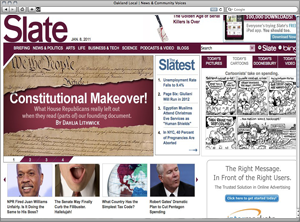Indeed, Slate’s relationship with its audience has become a hallmark of the site’s identity. “If you look at Slate readers, they’re really well-educated and they’re really interesting and provocative and in the last few years we’ve really looked at ways to take advantage of this in intelligent ways,” says Plotz. While many publications have experimented with reader-generated content, few have gone as far as Slate, where the process has moved off the web and into the real world. Through a partnership with the New America Foundation, Slate has begun holding half a dozen conferences a year in which readers have met up to crowd-source problems in person, the results of which have been published online for yet more audience participation. Not that Slate has lost faith in purely journalist-generated content. In fact, it’s one of the few publications in any medium investing in long-form writing. Each member of Slate’s editorial staff is required to take four to six weeks out of each year to focus on a project outside of the news cycle. Internally these are called “Fresca” projects, and they’ve led to some of Slate’s most worthwhile content. “There’s always been the notion at Slate where if you had an idea for some kind of bigger project you could go out and do it,” says Plotz, who talked about Slate’s ongoing efforts in long-form content at South by Southwest in 2012.
Founded by Michael Kinsley, named “Editor of the Year” by CJR in 1999 for his work on the publication, Slate was originally part of Microsoft. It was purchased by The Washington Post Company in 2004 and is now the flagship/namesake of The Slate Group, a quiver of web properties that includes The Root and Foreign Policy (though FP is unique in the Slate group as a print magazine founded in 1970, it too boasts a robust web presence). [UPDATE: Foreign Policy is no longer part of The Slate Group as The Washington Post Company spun the magazine and its website into a separate division called FP Group in January 2012.] Members of The Slate Group share business, technology, and marketing resources. Until recently, Slate and The Washington Post had shared a digital ad sales team. That changed in late 2011, when the publication was finally allowed to create its own sales and marketing team. According to Ad Age, part of the reason for this was the site’s “increasingly moving beyond traditional display advertising… and crafting more custom sponsorship packages for its advertisers” such as videos, product placements, and widgets.
In another sign of progress, Slate finally did away with Gutenberg, the CMS it had been using for 10 years. Just prior to the launch of the new CMS, Slate worked on improvements to story metadata that significantly increased the site’s search compatability: search traffic in August 2011 was 22 percent higher than the same month in 2010.
Slate suffered a major loss in 2011 when it laid off media columnist Jack Shafer, “Chatterbox” columnist Timothy Noah, and two other full-time editorial staffers. As Erik Wemple reported at the time, the move came shortly after The Washington Post Company had a particularly lousy quarter in which online publishing revenues dropped 13 percent.
The site’s reporting continues to gain notice, however. In 2011, Slate took home the National Magazine Award for General Excellence in the category of Digital Media, News and Opinion and tied with National Geographic for the most NMA Digital Ellie nominations.
The continued success of Slate can really be attributed to the way it has combined old-fashioned articles and reporting with web 2.0 concepts, such as multimedia presentations (including an active podcast life and a video-only offshoot) and readership involvement. They’re both fundamental parts of the publication, and while it continues to evolve over time, Slate has adjusted its methods but never its goals. “The thing that we have to always give our readers is that when they come to Slate they get a perspective that is delivered with intellectual rigor and wit, that’s interesting and compelling and unexpected,” says Plotz. “I think we do that day after day after day very well.”
 NEW YORK, NEW YORK — “Slate’s overall mission is to create really intelligent, witty, durable web journalism; [that mission] has been more or less the same since 1996,” says David Plotz, the site’s editor. Slate is perhaps best known as one of the first publications to prove that a high-quality editorial product could exist and thrive online, but it didn’t earn that reputation just by mimicking print standards–the site has excelled at leveraging its native medium. No publication bats 1.000, but Slate’s multimedia and interactive offerings have been consistently innovative, and often a big hit with readers.
NEW YORK, NEW YORK — “Slate’s overall mission is to create really intelligent, witty, durable web journalism; [that mission] has been more or less the same since 1996,” says David Plotz, the site’s editor. Slate is perhaps best known as one of the first publications to prove that a high-quality editorial product could exist and thrive online, but it didn’t earn that reputation just by mimicking print standards–the site has excelled at leveraging its native medium. No publication bats 1.000, but Slate’s multimedia and interactive offerings have been consistently innovative, and often a big hit with readers.
